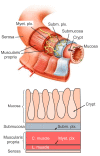The Macro- and Micro-Mechanics of the Colon and Rectum I: Experimental Evidence
- PMID: 33086503
- PMCID: PMC7712174
- DOI: 10.3390/bioengineering7040130
The Macro- and Micro-Mechanics of the Colon and Rectum I: Experimental Evidence
Abstract
Many lower gastrointestinal diseases are associated with altered mechanical movement and deformation of the large intestine, i.e., the colon and rectum. The leading reason for patients' visits to gastrointestinal clinics is visceral pain, which is reliably evoked by mechanical distension rather than non-mechanical stimuli such as inflammation or heating. The macroscopic biomechanics of the large intestine were characterized by mechanical tests and the microscopic by imaging the load-bearing constituents, i.e., intestinal collagen and muscle fibers. Regions with high mechanical stresses in the large intestine (submucosa and muscularis propria) coincide with locations of submucosal and myenteric neural plexuses, indicating a functional interaction between intestinal structural biomechanics and enteric neurons. In this review, we systematically summarized experimental evidence on the macro- and micro-scale biomechanics of the colon and rectum in both health and disease. We reviewed the heterogeneous mechanical properties of the colon and rectum and surveyed the imaging methods applied to characterize collagen fibers in the intestinal wall. We also discussed the presence of extrinsic and intrinsic neural tissues within different layers of the colon and rectum. This review provides a foundation for further advancements in intestinal biomechanics by synergistically studying the interplay between tissue biomechanics and enteric neurons.
Keywords: colorectum; experiments; large intestine; mechanotransduction; multi-layered.
Conflict of interest statement
The authors claim no conflict of interest.
Figures


References
-
- Feng B., La J.H., Schwartz E.S., Gebhart G.F. Irritable bowel syndrome: Methods, mechanisms, and pathophysiology. Neural and neuro-immune mechanisms of visceral hypersensitivity in irritable bowel syndrome. Am. J. Physiol. Gastrointest. Liver Physiol. 2012;302:G1085–G1098. doi: 10.1152/ajpgi.00542.2011. - DOI - PMC - PubMed
Publication types
Grants and funding
LinkOut - more resources
Full Text Sources

